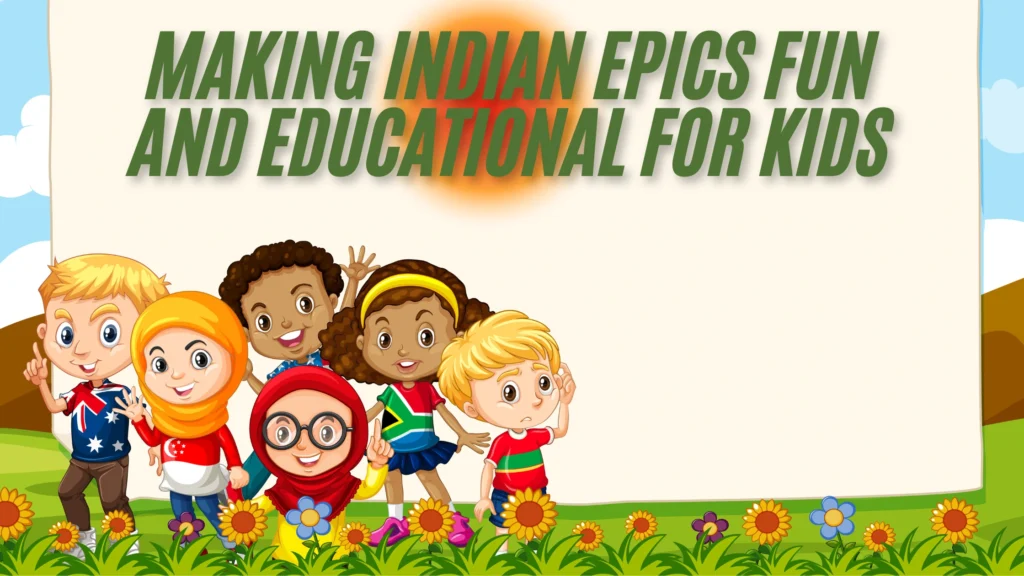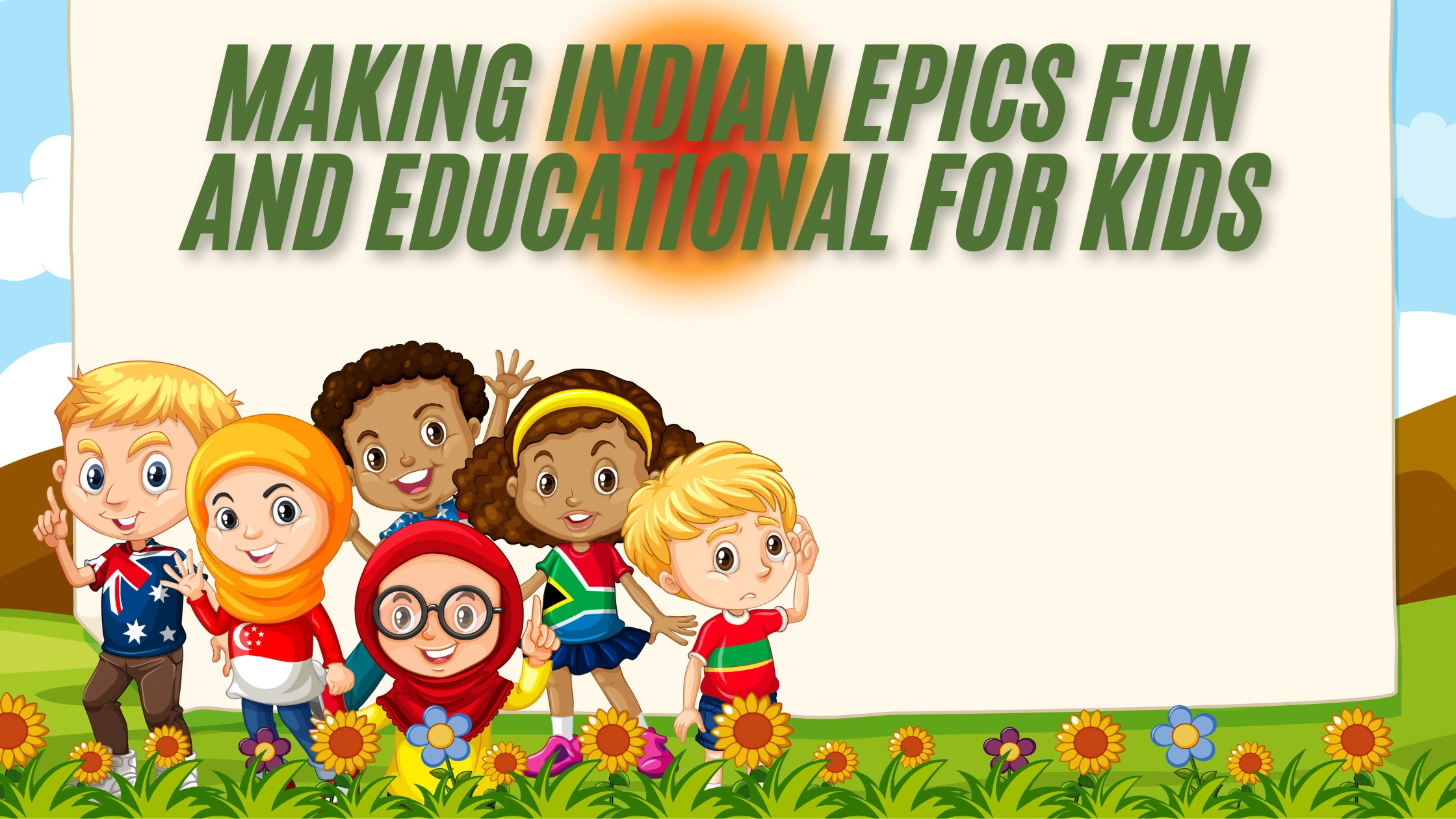Indian epics like the Mahabharata and Ramayana are not just stories; they are treasure troves of wisdom, values, and life lessons. For centuries, these tales have shaped the moral and cultural fabric of Indian society. But in today’s world, where technology often overshadows tradition, how can parents and educators make these epics engaging and educational for kids?
Here’s a guide to introducing Indian epics to children in a way that’s both fun and meaningful.

1. Simplify the Stories
Kids can find the complex narratives of epics overwhelming. Simplify the tales into shorter, easy-to-understand versions while retaining their essence. For example:
- Instead of narrating the entire Mahabharata, start with Arjuna’s focused learning under Dronacharya.
- From the Ramayana, narrate the story of Hanuman’s leap to Lanka to instill the value of courage and determination.
2. Use Interactive Storytelling
Interactive storytelling can capture a child’s attention better than mere narration.
- Role-Playing: Assign roles from the epics to family members during storytelling sessions.
- Puppet Shows: Use puppets to enact famous scenes like Krishna lifting the Govardhan mountain or the vanaras building the Ram Setu.
- Q&A Sessions: Encourage kids to ask questions about the stories, turning it into a two-way learning experience.
3. Integrate Art and Craft
Engage children by combining storytelling with art and craft activities.
- Draw Characters: Encourage kids to draw or paint their favorite characters like Hanuman or Ganesha.
- Create Scene Models: Build small dioramas of epic scenes, such as the Kurukshetra battlefield or Sita’s Ashok Vatika, using clay or paper.
- DIY Crowns and Bows: Let them create props like Krishna’s crown or Arjuna’s bow to deepen their connection to the characters.
4. Use Age-Appropriate Media
With advancements in media, there are numerous resources to bring epics to life:
- Animated Movies and Series: Popular shows and animated films based on Ramayana and Mahabharata are available on streaming platforms.
- Story Apps: Download kid-friendly apps that narrate these epics in an interactive way.
- YouTube Channels: Look for channels that simplify these stories with colorful animations and narrations.
5. Teach Values Through Stories
Indian epics are rich in moral lessons. Highlight these values through the tales:
- Teamwork: The building of the Ram Setu emphasizes teamwork and unity.
- Honesty: Yudhishthira’s truthfulness during difficult times.
- Kindness: Lord Rama’s compassion towards all beings, including animals and vanaras.
By tying these lessons to everyday scenarios, children can relate to the morals and apply them in their lives.
6. Celebrate Festivals with Context
Festivals like Diwali and Dussehra are deeply rooted in Indian epics. Use these occasions to narrate the backstory:
- During Diwali, explain how Lord Rama returned to Ayodhya after defeating Ravana.
- On Dussehra, narrate the story of good triumphing over evil through Rama’s victory or the defeat of Mahishasura by Goddess Durga.
Pair these narrations with related activities like decorating diyas or creating Ravana effigies.
7. Introduce Books and Comics
Indian epics have been beautifully adapted into comics and books that appeal to children.
- Amar Chitra Katha offers a wide range of illustrated stories.
- Storybooks like “The Blue Umbrella” by Ruskin Bond weave modern interpretations of Indian moral tales.
- Audiobooks are a great option for kids who love to listen rather than read.
8. Host Epic-Themed Contests
Organize events at home or in schools to make learning about epics more fun:
- Quiz Contests: Test kids’ knowledge of characters and events.
- Costume Days: Have them dress up as their favorite epic hero or heroine.
- Story Writing: Encourage them to create their own short stories inspired by the epics.
Read more:-
प्राचीन भारतीय ग्रंथों से बच्चों के लिए जीवन की सीख
Timeless Wisdom from the Bhagavad Gita for Young Minds
क्या बच्चों को देखनी चाहिए ‘भूल भुलैया 3’? जानिए इस फिल्म में बच्चों के लिए क्या है खास!
9. Encourage Cultural Activities
Indian classical dance forms like Bharatanatyam and Kathak often narrate stories from the epics.
- Enroll children in dance or drama classes where they can perform episodes from the Ramayana or Mahabharata.
- Visit theaters that showcase epic-based plays or ballets for a live storytelling experience.
10. Relate Epics to Real Life
Help kids understand how the lessons from epics apply to their own lives.
- Arjuna’s focus during archery can inspire them to concentrate on studies.
- Rama’s respect for elders can encourage them to value family relationships.
- Krishna’s playful nature teaches the importance of balancing responsibility with fun.
Indian epics are a goldmine of lessons that can guide children in their formative years. By presenting these stories creatively and interactively, you can help them appreciate the depth and richness of their heritage.
Let’s make these timeless tales a part of every child’s upbringing, ensuring that the wisdom of Indian culture continues to inspire generations.


